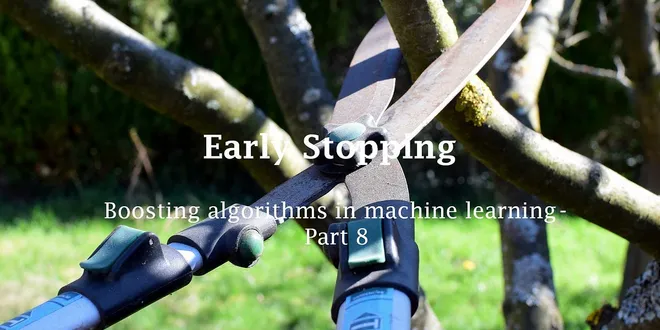Early Stopping

Early stopping of Gradient Boosting
Early stopping of Gradient Boosting Gradient boosting is an ensembling technique where several weak learners (regression trees) are combined to yield a powerful single model, in an iterative fashion. ...
📚 Read more at Scikit-learn Examples🔎 Find similar documents

Early Stopping: Why Did Your Machine Learning Model Stop Training?
When training supervised machine learning models, early stopping is a commonly used technique to mitigate overfitting. Early stopping involves monitoring a model’s performance on a validation set duri...
📚 Read more at Towards Data Science🔎 Find similar documents

Gradient Boosting: To Early Stop or Not To Early Stop
Gradient-Boosted Trees: To Early Stop or Not to Early Stop? Leveraging early stopping for LightGBM, XGBoost, and CatBoost Photo by Julian Berengar Sölter Gradient-boosted decision trees (GBDTs) curre...
📚 Read more at Towards Data Science🔎 Find similar documents

Use Early Stopping to Halt the Training of Neural Networks At the Right Time
Last Updated on August 25, 2020 A problem with training neural networks is in the choice of the number of training epochs to use. Too many epochs can lead to overfitting of the training dataset, where...
📚 Read more at Machine Learning Mastery🔎 Find similar documents

Pause for Performance: The Guide to Using Early Stopping in ML and DL Model Training
This article will explain the concept of early stopping, its pros and cons, and its implementation using Scikit-Learn and TensorFlow. Photo by Aleksandr Kadykov on Unsplash Table of Content 1. Introd...
📚 Read more at Towards AI🔎 Find similar documents

Predictive Early Stopping — A Meta Learning Approach
Predictive Early Stopping is a state-of-the-art approach for speeding up model training and hyperparameter optimization. Our benchmarking studies have shown that Predictive Early Stopping can speed…
📚 Read more at Towards Data Science🔎 Find similar documents

A Practical Introduction to Early Stopping in Machine Learning
In this article, we will focus on adding and customizing Early Stopping in our machine learning model and look at an example of how we do this in practice with Keras and TensorFlow 2.0. In machine…
📚 Read more at Towards Data Science🔎 Find similar documents

Early Stopping
Most Machine Learning models have hyper-parameters which are fixed by the user in order to structure the training of these models on the underlying data sets. For example, you need to specify the…
📚 Read more at Towards Data Science🔎 Find similar documents

Early stopping of Stochastic Gradient Descent
Early stopping of Stochastic Gradient Descent Stochastic Gradient Descent is an optimization technique which minimizes a loss function in a stochastic fashion, performing a gradient descent step sampl...
📚 Read more at Scikit-learn Examples🔎 Find similar documents

Keras EarlyStopping Callback to train the Neural Networks Perfectly
In the Arrowverse series, When Arrow says to Flash — “Take your own advice, wear a mask”, “You can be better” — Well, I thought, maybe if we have some same kind of feature in Neural Networks where th...
📚 Read more at Towards AI🔎 Find similar documents

Activate Early Stopping in Boosting Algorithms to Mitigate Overfitting
In Part 7, I’ve mentioned that overfitting can easily happen in boosting algorithms. Overfitting is one of the main drawbacks of boosting techniques. Early stopping is a special technique that can be…...
📚 Read more at Towards Data Science🔎 Find similar documents

EarlyStopping and LiveLossPlot Callbacks in TensorFlow, Keras, and Python
Member-only story EarlyStopping and LiveLossPlot Callbacks in TensorFlow, Keras, and Python How to Improve Your Model Training Time and to Prevent Overfitting Using EarlyStopping and Plot the Losses a...
📚 Read more at Towards AI🔎 Find similar documents

